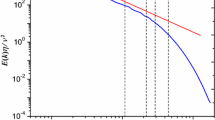Abstract
The main objective of the current study is to investigate the effect of either non-resolved (point particles) or fully resolved particles on a field of isotropic, either stationary or decaying turbulence using direct numerical simulation (DNS), clarifying how those different settings influence the turbulence statistics.
Access this chapter
Tax calculation will be finalised at checkout
Purchases are for personal use only
Similar content being viewed by others
References
Abdelsamie, A.H., Lee, C.: Decaying versus stationary turbulence in particles-laden isotropic turbulence: turbulence modulation mechanism. Phys. Fluids 24, 015106 (2012)
Abdelsamie, A.H., Lee, C.: Decaying versus stationary turbulence in particle-laden isotropic turbulence: heavy particle statistics modifications. Phys. Fluids 25, 033303 (2013)
Abdelsamie, A.H., Chittipotula, T., Lee, C., Thévenin, D.: Stationary and decaying turbulence modulation by finite size fully resolved particles. In: 8th International Conference on Multiphase Flow, Jeju, Korea, (2013)
Boivin, M., Simonin, O., Squires, K.D.: Direct numerical simulation of turbulence modulation by particles in isotropic turbulence. J. Fluid Mech. 375, 235–263 (1998)
Crowe, C., Sommerfeld, M., Tsuji, Y.: Multiphase Flows with Droplets and Particles. CRC, Boca Raton (1998)
Dance, S.L., Climent, E., Maxey, M.R.: Collision barrier effects on the bulk flow in a random suspension. Phys. Fluids 16, 828–831 (2004)
Druzhinin, O.A., Elghobashi, S.: On the decay rate of isotropic turbulence laden with microparticles. Phys. Fluids 11, 602–610 (1999)
Druzhinin, O.A.: The influence of particle inertia on the two-way coupling and modification of isotropic turbulence by microparticles. Phys. Fluids 13, 3738–3755 (2001)
Elghobashi, S., Truesdell, G.C.: On the two-way interaction between homogeneous turbulence and dispersed solid particles. I: Turbulence modification. Phys. Fluids A 5, 1790–1801 (1993)
Ferrante, A., Elghobashi, S.: On the physical mechanisms of two-way coupling in particle laden isotropic turbulence. Phys. Fluids 15, 315–329 (2003)
Kempe, T., Fröhlich, J.: Collision modelling for the interface resolved simulation of spherical particles in viscous fluids. J. Fluid Mech. 709, 445–489 (2012)
Lucci, F., Ferrante, A., Elghobashi, S.: Modulation of isotropic turbulence by particles of taylor length-scale size. J. Fluid Mech. 650, 5–55 (2010)
Mohd-Yusof, J.: Combined Immersed-Boundary/B-spline Methods for Simulations of Flow in Complex Geometries. CTR Annual Research Briefs, Stanford Univ., pp. 317–327 (1997)
Mohd-Yusof, J.: Development of Immersed Boundary Methods for Complex Geometries. CTR Annual Research Briefs, Stanford Univ., pp. 325–336 (1998)
Peskin, C.: The immersed boundary method. Acta Numer. 11, 1–39 (2002)
Roma, A., Peskin, C., Berger, M.: An adaptive version of the immersed boundary method. J. Comput. Phys. 153, 509–534 (1999)
Sundaram. S., Collins, L. R.: A numerical study of the modulation of isotropic turbulence by suspended particles. J. Fluid Mech. 379, 105–143 (1999)
Uhlmann, M.: An immersed boundary method with direct forcing for the simulation of particulate flows. J. Comput. Phys. 209, 448–476 (2005)
Acknowledgments
The authors would like to thank Prof. C. Lee for his recommendations and discussions about spectral methods. The help of Dr. G. Janiga and Dr. G. Fru concerning post-processing is gratefully acknowledged.
Author information
Authors and Affiliations
Corresponding author
Editor information
Editors and Affiliations
Rights and permissions
Copyright information
© 2015 Springer International Publishing Switzerland
About this paper
Cite this paper
Abdelsamie, A.H., Thévenin, D. (2015). Modulation of Isotropic Turbulence by Resolved and Non-resolved Spherical Particles. In: Fröhlich, J., Kuerten, H., Geurts, B., Armenio, V. (eds) Direct and Large-Eddy Simulation IX. ERCOFTAC Series, vol 20. Springer, Cham. https://doi.org/10.1007/978-3-319-14448-1_78
Download citation
DOI: https://doi.org/10.1007/978-3-319-14448-1_78
Published:
Publisher Name: Springer, Cham
Print ISBN: 978-3-319-14447-4
Online ISBN: 978-3-319-14448-1
eBook Packages: EngineeringEngineering (R0)




